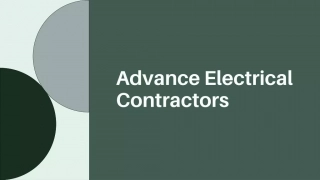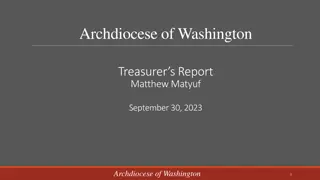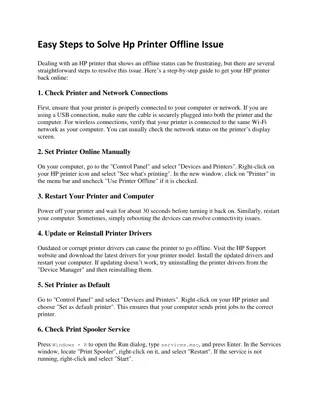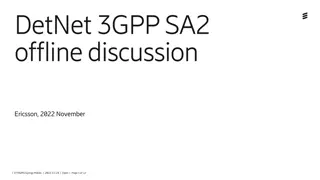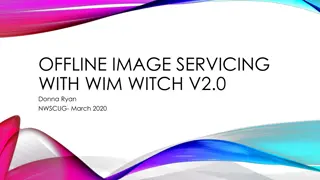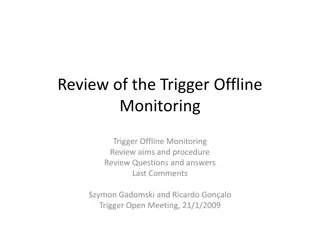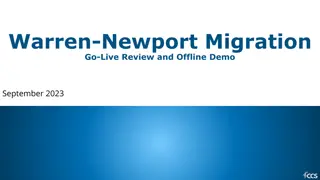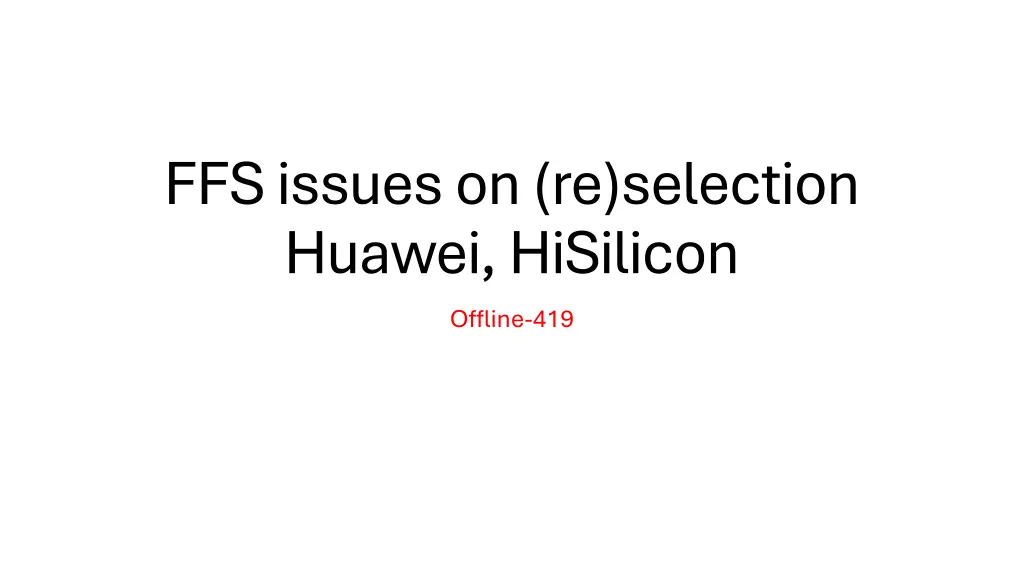
FFS Issues on Huawei HiSilicon Reselection Procedure
"Learn about the FFS issues encountered during the (re)selection of Huawei and HiSilicon components, particularly focusing on relay reselection procedures, triggering conditions, notifications, and link quality degradation. Explore the detailed PC5 signaling designs and implications for L2 and L3 deployments."
Download Presentation

Please find below an Image/Link to download the presentation.
The content on the website is provided AS IS for your information and personal use only. It may not be sold, licensed, or shared on other websites without obtaining consent from the author. If you encounter any issues during the download, it is possible that the publisher has removed the file from their server.
You are allowed to download the files provided on this website for personal or commercial use, subject to the condition that they are used lawfully. All files are the property of their respective owners.
The content on the website is provided AS IS for your information and personal use only. It may not be sold, licensed, or shared on other websites without obtaining consent from the author.
E N D
Presentation Transcript
FFS issues on (re)selection Huawei, HiSilicon Offline-419
FFSs for Relay Reselection Procedure L2 multi-hop U2N Remote UE in idle/inactive triggers relay reselection upon PC5-RRC signaling from the first relay UE indicating (FFS on the detailed PC5 design design): cell reselection, handover, Uu RLF, or Uu RRC connection establishment/resume failure between the last relay UE and network. release of RRC connection between an intermediate relay UE and the network. PC5 RLF or PC5-S connection release between the multi-hop U2N Relay UE(s). FFS: link quality degradation of the upstream links resulting in a notification. FFS: link quality degradation of the upstream links resulting in a notification. FFS if any of these conditions can occur without notifying the remote UE (e.g., allowing recovery by the intermediate FFS if any of these conditions can occur without notifying the remote UE (e.g., allowing recovery by the intermediate relay UE). relay UE). FFS on the signalling contents of the PC5 FFS on the signalling contents of the PC5- -RRC indication from the first relay UE. RRC indication from the first relay UE. FFS applicability to L3. FFS applicability to L3. The intermediate relay UE can adopt the same AS triggering condition of relay (re)selection of the R17 remote UE. FFS upper layer conditions and whether the spec FFS upper layer conditions and whether the spec impact will be modelled as a separate relay UE behaviour or through functioning as impact will be modelled as a separate relay UE behaviour or through functioning as a remote UE. a remote UE. Upon intermediate relay UE performing relay (re)selection, it can notify its child node. If the cause of (re)selection already causes a notification, there is no double-trigger of the notification. FFS if (re)selection as such is captured as a cause of notification (intention to maintain no double FFS if (re)selection as such is captured as a cause of notification (intention to maintain no double- -trigger) FFS if the notification is required in all cases FFS if the notification is required in all cases FFS on the detailed PC5- -RRC RRC signaling signaling trigger)
FFS: link quality degradation of the upstream links resulting in a notification. R2-2502609 proposes to reuse the R17 mechanism where if the upstream PC5 links in the multi-hop chain degrade either the intermediate or the first relay UE will trigger relay reselection or cell selection when they are in IDLE/INACTIVE state or a path switch when they are in RRC_CONNECTED state. Upon relay (re)selection or cell selection or path switch, the upstream relay UE in the multi-hop chain will send a notification message to the child relay UE, which will then forward it to the remote UE. Proposal 3: Link quality degradation of the upstream links will lead to path switching Proposal 3: Link quality degradation of the upstream links will lead to path switching (for the CONNECTED state) or relay (re)selection or cell selection (for the IDLE/INACTIVE (for the CONNECTED state) or relay (re)selection or cell selection (for the IDLE/INACTIVE state), rather than triggering an immediate notification. The relay UE will send a state), rather than triggering an immediate notification. The relay UE will send a notification once path switching or relay (re)selection or cell selection occurs notification once path switching or relay (re)selection or cell selection occurs. FFS if path switching happens in the same cell CompanyViews Link quality degradation Notification Needed: ZTE, IDC Link quality degradation Notification not needed: NEC, QC, E//, OPPO, APPLE, VIVO, LG, Samsung, Kyocera, HW
FFS if any of these conditions can occur without notifying the remote UE (e.g., allowing recovery by the intermediate relay UE). U2N Remote UE intermediate relay UE first relay UE last relay UE gNB U2N Remote UE intermediate relay UE first relay UE last relay UE gNB R2-2502609 proposes to extend the single hop R17 notification mechanism to multihop. It is beneficial for the remote UE to be informed by the serving Intermediate Relay UE/First Relay UE when it receives a notification message indicating cell reselection, handover, Uu RLF, or Uu RRC connection establishment/resume failure of the U2N Last Relay UE. This allows the remote UE to take corrective action egperform reselection. Similarlyit is also beneficial for the intermediate and first relay UE to either forward or send the notification message to the child UE downstream so that remote is informed of the PC5-RLFs Proposal 4: The notification message received from the U2N Last Relay UE indicating a failure on the Proposal 4: The notification message received from the U2N Last Relay UE indicating a failure on the Uu interface should be forwarded downstream by the Intermediate/First Relay UE to the Remote UE. To interface should be forwarded downstream by the Intermediate/First Relay UE to the Remote UE. To achieve this, we can reuse the PC5 RRC Notification message as a baseline. achieve this, we can reuse the PC5 RRC Notification message as a baseline. ?Proposal 6. If there are multiple relay UEs in the multi ?Proposal 6. If there are multiple relay UEs in the multi- -hop chain, there is a possibility of encountering a multi a multi- -hop failure on the PC5 links. In this case, it would be beneficial for the child relay UE to forward hop failure on the PC5 links. In this case, it would be beneficial for the child relay UE to forward or send the notification message downstream until the Notification Message is delivered to the Remote or send the notification message downstream until the Notification Message is delivered to the Remote UE. FFS if it is needed for PC5 failures in the upstream links UE. FFS if it is needed for PC5 failures in the upstream links FFS to check if some mechanism for forwarding exists in SA2 specs. CompanyViews Notification Needed: Samsung (only for Uu), E//(only for Uu), OPPO (all cases), ZTE (all cases), LG (all cases) Notification not needed in certain cases: QC, Kyocera Uu hop chain, there is a possibility of encountering
FFS if any of these conditions can occur without notifying the remote UE (e.g., allowing recovery by the intermediate relay UE). R2-2502609 proposes to not to have group mobility mechanism for R19. Considering that group handover/mobility is not supported since R17, it is simpler to adhere to the legacy mechanism where the multi-hop U2N Remote UE triggers relay reselection when cell reselection, handover, Uu RLF, or UuRRC connection establishment/resume failure is indicated by the multi-hop U2N Relay UE(s) ?Proposal 5: Failure Scenarios in which the remote UE is not notified and ?Proposal 5: Failure Scenarios in which the remote UE is not notified and recovery is handled by the intermediate relay UE not considered to be recovery is handled by the intermediate relay UE not considered to be supported in R19 supported in R19. . Company Views Remote UE always notified: OPPO, HW, ZTE Cases Remote UE is not notified: Samsung, IDC, LG, QC
FFS on the signalling contents of the PC5-RRC indication from the first relay UE. For the content in the PC5-RRC indication when an intermediate relay UE forward the notification message received from the parent relay UE, there can be two options as proposed in R2-2502609. Option 1: Intermediate relay UE forward the PC5-RRC indication from the parent relay UE without the content update. Option 2: The intermediate relay UE updates the content in the notification message based on the reaction of the intermediate relay UE when it receives the notification message from parent. If the intermediate relay UE forward the notification message form the parent relay UE without the content update, there will be some ambiguity since some failure cause are specific to the last relay UE will not happen at the intermediate relay UE. ?Proposal 7. Upon receiving the notification message form the ?Proposal 7. Upon receiving the notification message form the parent relay UE, the intermediate relay UE/first relay UE may parent relay UE, the intermediate relay UE/first relay UE may update the indication in the notification message to the remote UE update the indication in the notification message to the remote UE to indicate the action it has taken. to indicate the action it has taken. CompanyViews Option 1: Option 2:Samsung, E///, Oppo, Kocera , IDC, LG
FFS applicability to L3 R2-2502609 proposes that the RAN 2 part of the scope is limited to the L2 Mulithop Relay design RAN 2 will not look into L3 aspects. . Proposal 8: RAN2 will focus solely on the L2 Multi Proposal 8: RAN2 will focus solely on the L2 Multi- -hop Relay design. Therefore, we do not need to discuss the applicability of L3 Multi not need to discuss the applicability of L3 Multi- -hop relays. company Views Most of the companies agree with P8 hop Relay design. Therefore, we do hop relays.
Proposal from 419 Offline Link quality degradation Link quality degradation Proposal 1: Notification for Link quality degradation is not supported. Link quality degradation of the upstream links will eventually lead to path switching (for the CONNECTED state) or relay (re)selection or cell selection (for the IDLE/INACTIVE state). The relay UE will send a notification once path switching or relay (re)selection or cell selection occurs. FFS on sending the notification if the path switching happens in the same cell. Notification from the upstream Relay UE Notification from the upstream Relay UE Proposal 2: The notification message received from the U2N Last Relay UE indicating a failure on the Uu interface should be forwarded downstream by the Intermediate/First Relay UE to the Remote UE. To achieve this, we can reuse the PC5 RRC Notification message as a baseline. Proposal 3. RAN 2 to further discuss and agree if the Notification Message is forwarded/ sent down stream, all the way to the Remote UE, in case PC5 Link failures on the multi hop chain are encountered. FFS to check if some higher layer mechanism for forwarding already exists in SA2 specs Group Mobility Support Group Mobility Support Proposal 4: RAN 2 to discuss if group mobility/handling is to be supported in R19 where recovery is handled by the intermediate relay UE without remote UE being notified of any failures. Content in the Notification Message Content in the Notification Message Proposal 5. Upon receiving the notification message form the parent relay UE, the intermediate relay UE/first relay UE may update the indication in the notification message to the remote UE to indicate the action it has taken. FFS if we need any new cause value
Proposal from 419 Offline Applicability to L3 Applicability to L3 Proposal 6: RAN2 will focus solely on the L2 Multi-hop Relay design. Therefore, we do not need to discuss the applicability of L3 Multi-hop relays.




